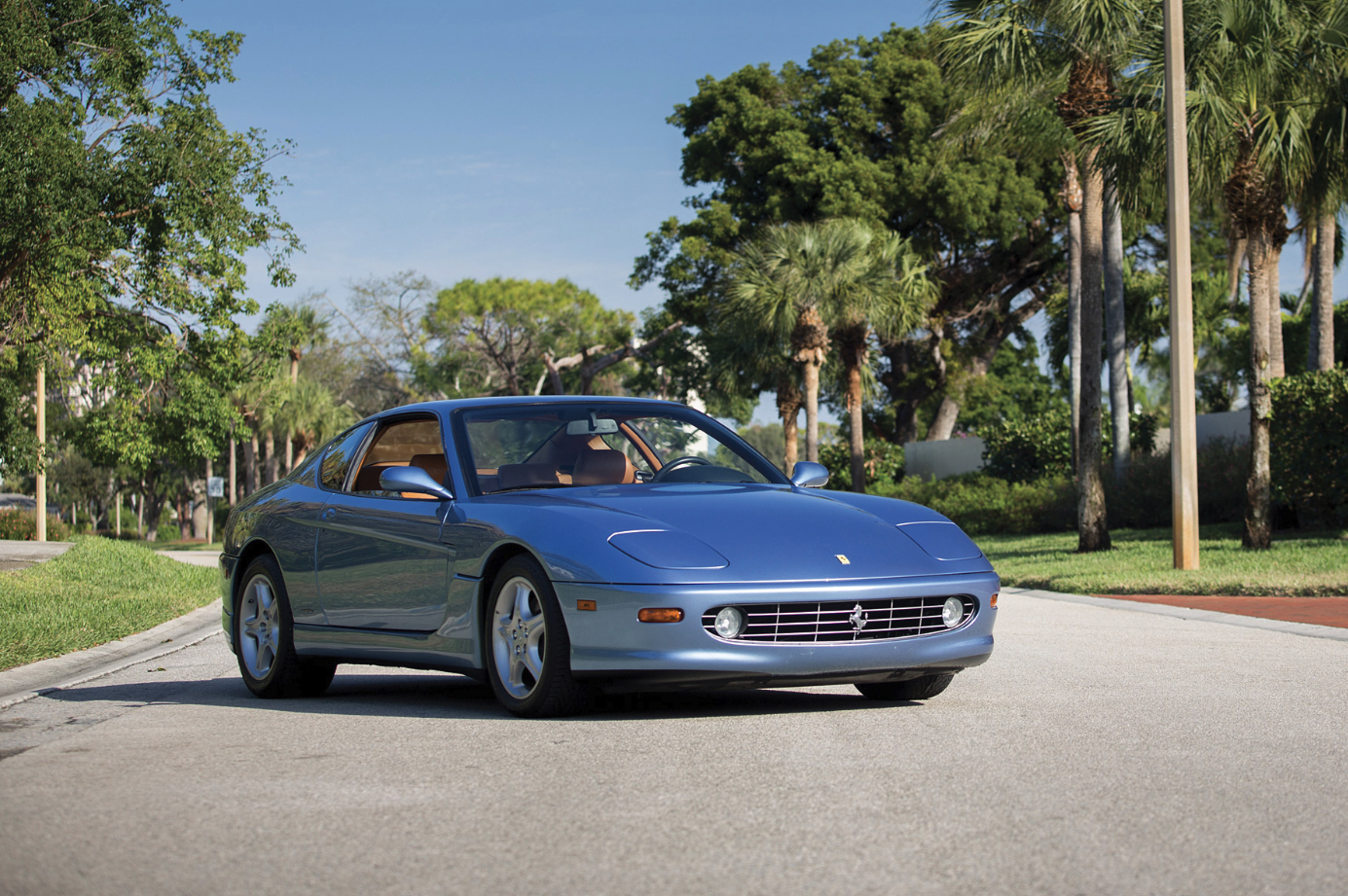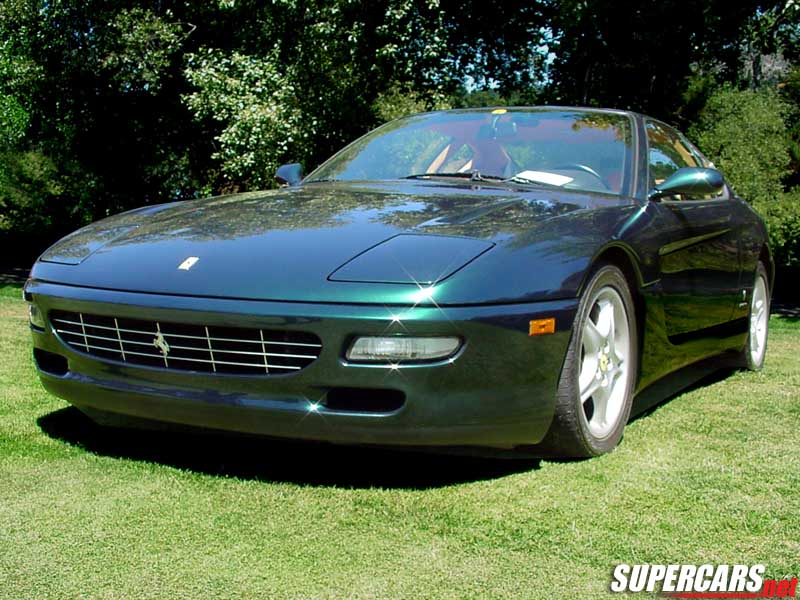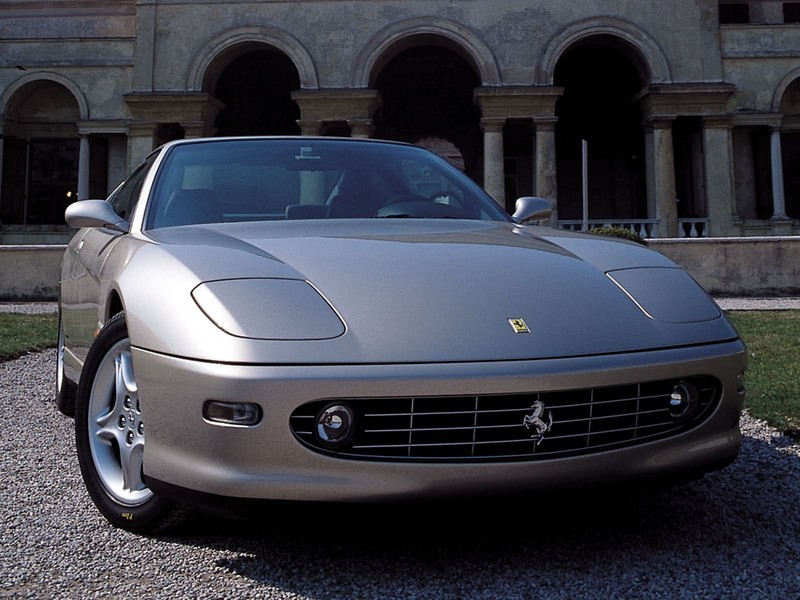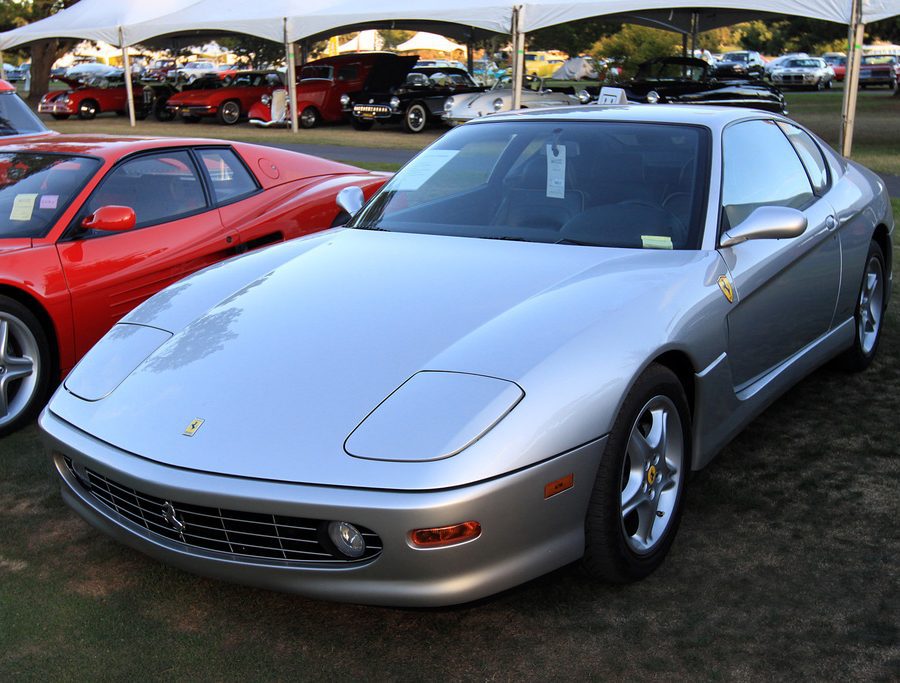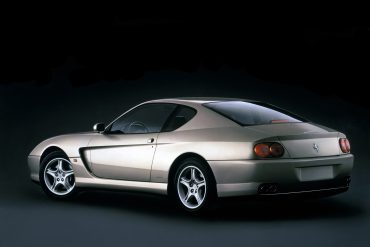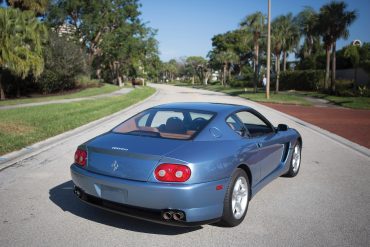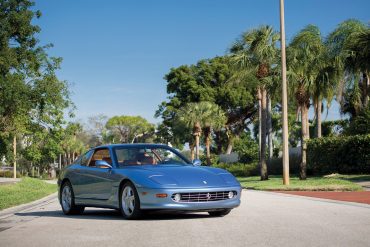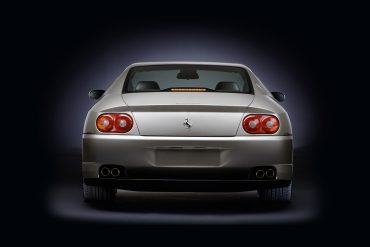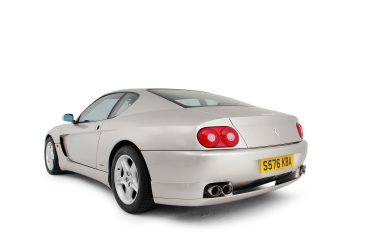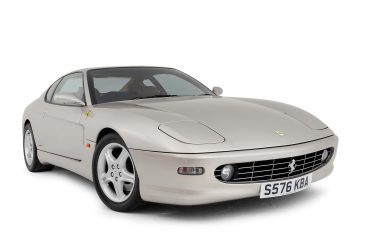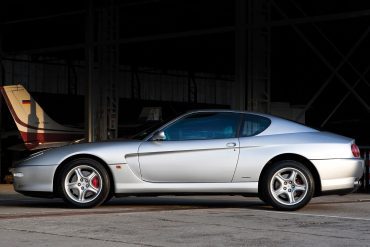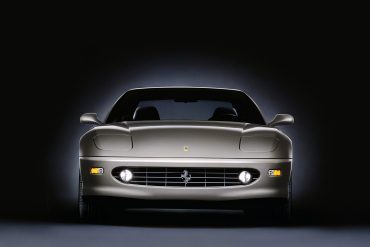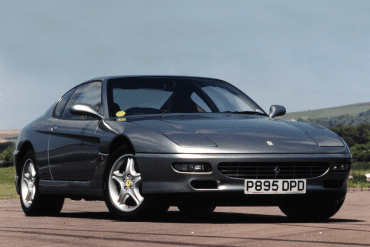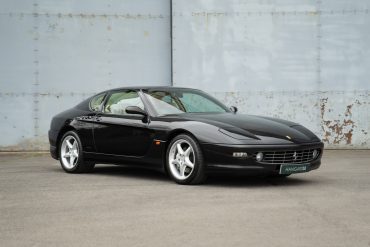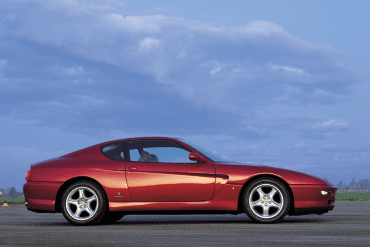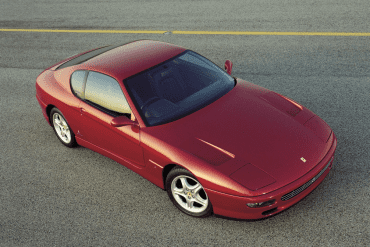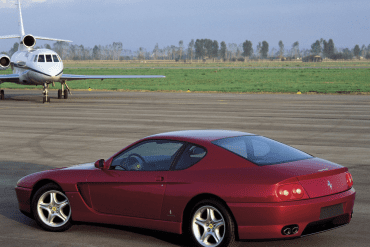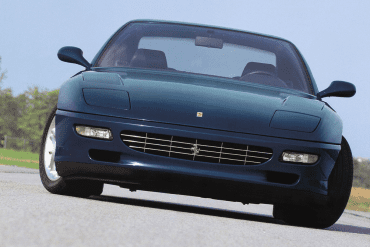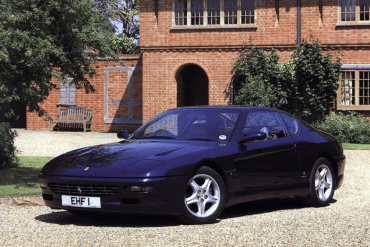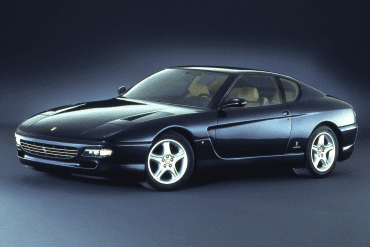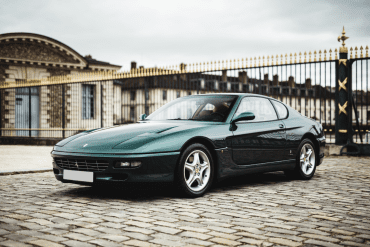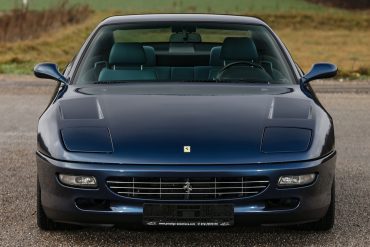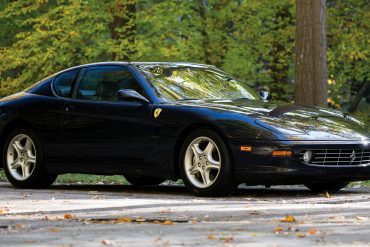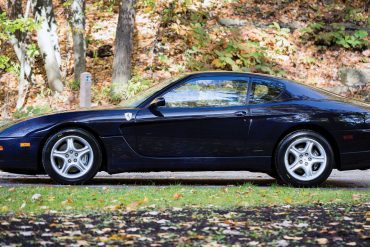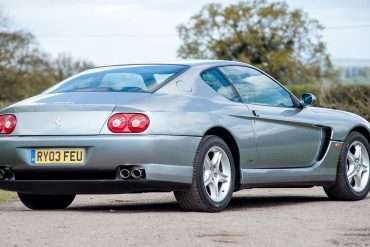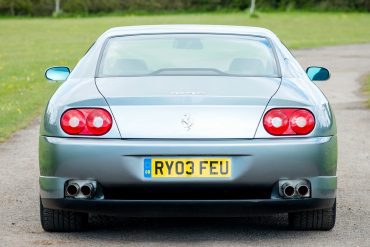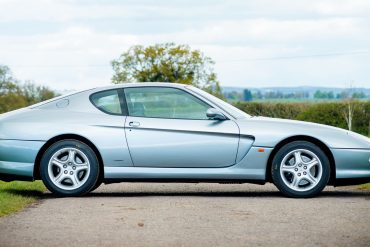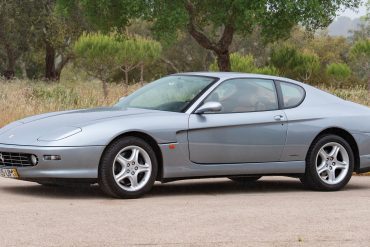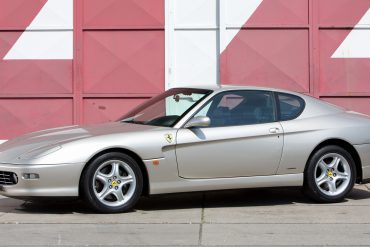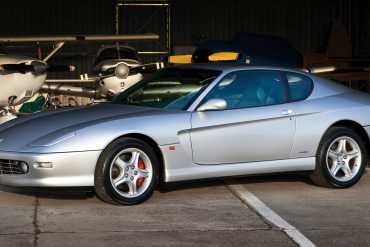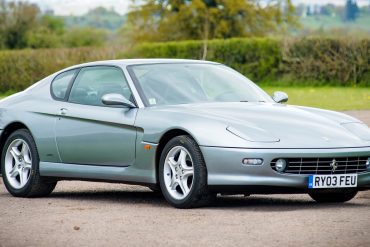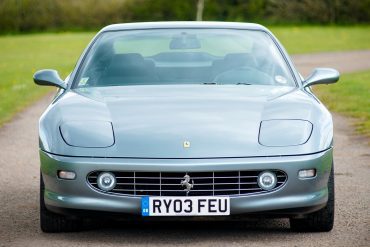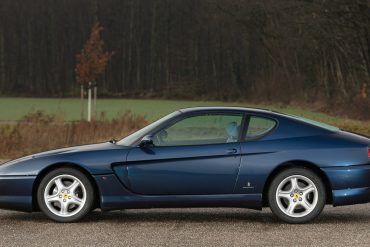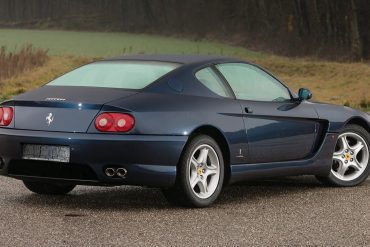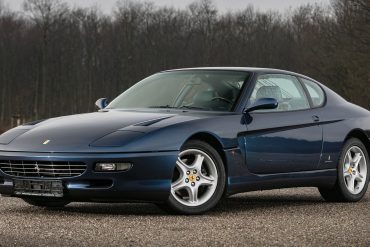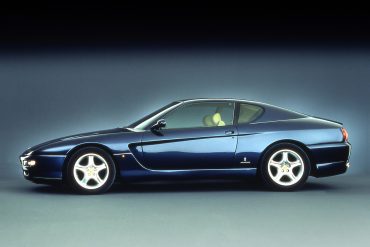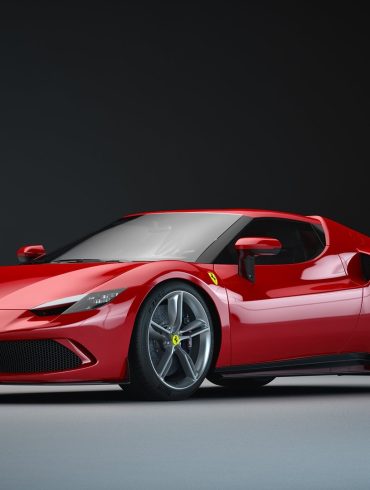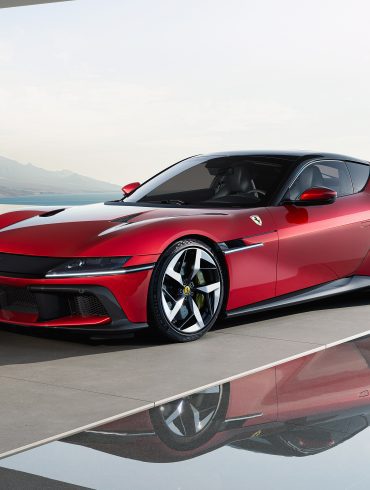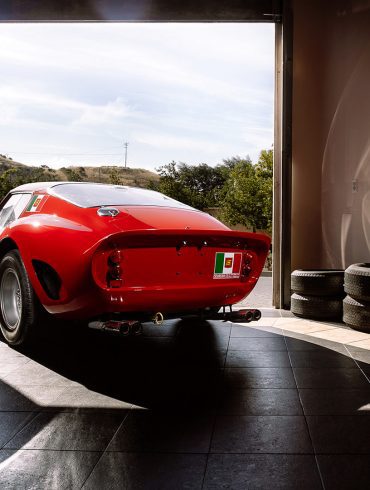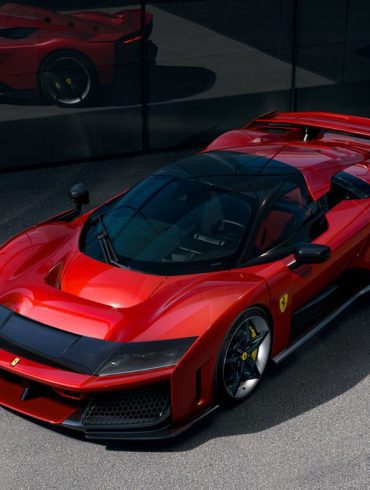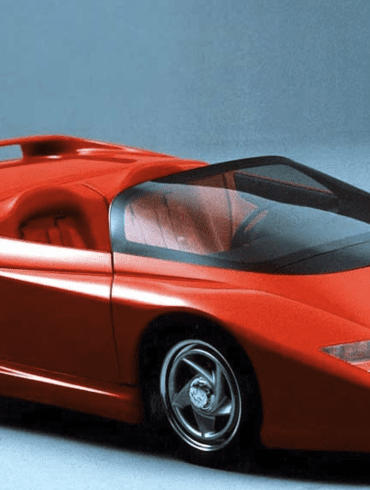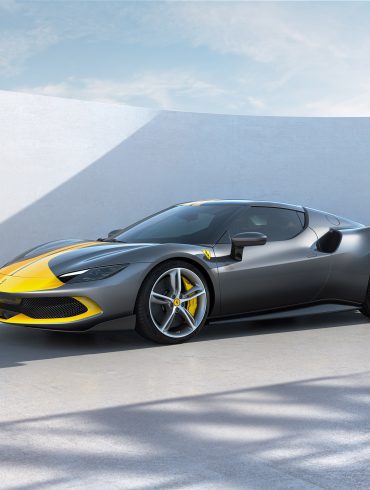Ferrari 456 (1992 – 1997) The Pininfarina-designed Ferrari 456 GT debuted in Europe in 1993 and was first available in the U.S. in 1995, and can be viewed as a replacement for the 365 GT 2+2 / 400 / 412 series. This front-engined 2+2 grand tourer had a 436 hp,...
Ferrari 456
The Ultimate Guide
Prepare to be swept away by the elegance and power of the Ferrari 456! This ultimate guide dives deep into the history of this often-overlooked grand tourer, exploring its design evolution, dissecting its impressive specifications, and providing a comprehensive buyer's guide to help you navigate the world of 456 variants, from the initial GT to the refined 456M GTA. Whether you're a seasoned enthusiast or a curious newcomer, this is your passport to the world of Ferrari's forgotten four-seater.
Overview / Variants / Models In-Depth / Buyer's Guide / Images
Ferrari 456 - The Understated V12 GT That Blends Power with Elegance
The Ferrari 456 is a unique gem in Ferrari’s lineup, combining a powerful V12 engine with a refined grand touring design that provides both speed and luxury for up to four occupants. Produced from 1992 to 2003, the Ferrari 456 remains one of the most understated Ferraris, known for its elegance and versatility as a true grand tourer.
The 456’s powerful engine, timeless design, and blend of comfort and performance make it an appealing model for those seeking a classic Ferrari that stands apart from the more aggressive sports cars. In this article, we’ll explore the history, variants, performance, legacy, and critical reception of the Ferrari 456.
Ferrari’s Return to the Four-Seater V12 GT
The Ferrari 456 was introduced in 1992 as Ferrari’s first four-seater V12 since the 412, which had been discontinued in 1989. Designed to blend Ferrari’s signature performance with the luxury of a grand tourer, the 456 was aimed at buyers who wanted a Ferrari that could comfortably carry passengers and luggage over long distances. This was a departure from Ferrari’s recent focus on two-seater, mid-engine sports cars and represented a return to the front-engine V12 format that had defined Ferrari’s heritage.
The 456 was named for its engine displacement of 456 cubic centimeters per cylinder, leading to its 5.5-liter V12 engine configuration. The “GT” suffix stood for “Gran Turismo,” reflecting the car’s role as a high-performance tourer. The car’s restrained, elegant design, penned by Pininfarina, emphasized sophistication over aggression, setting it apart from other Ferraris of the time.
Timeless Elegance from Pininfarina
The Ferrari 456 was styled by Pininfarina, Ferrari’s longtime design partner, who created a clean and timeless look that would age gracefully. The 456’s design is often considered one of Pininfarina’s most balanced and restrained, with smooth lines, a long hood, and minimalistic details that exude luxury rather than aggression.
Exterior Design: The 456’s low, sweeping hood and wide stance give it a purposeful look, while subtle touches like retractable headlights and a small rear spoiler create a sense of understated power. The 456’s aerodynamic profile includes carefully integrated air vents and a unique taillight design that contributed to its sophisticated appearance.
Interior Luxury: Inside, the 456 is outfitted with leather upholstery, high-quality materials, and a driver-focused layout. The interior offers a blend of comfort and sportiness, with ergonomic seats and space for four occupants. Ferrari paid careful attention to the cabin’s details, making it a true grand tourer that was comfortable for long journeys.
Motor Trend described the 456’s design as “graceful and refined,” noting that it “projects a sense of elegance that few sports cars achieve.”
Ferrari’s V12 Power in a Grand Tourer
The Ferrari 456 was powered by a 5.5-liter naturally aspirated V12 engine, producing 436 horsepower and 405 lb-ft of torque, making it one of the most powerful grand tourers of its time. Paired with either a gated 6-speed manual or a 4-speed automatic transmission, the 456 could reach 0 to 60 mph in around 5 seconds and had a top speed of 186 mph, impressive figures for a four-seat GT car in the early 1990s.
Manual Transmission Appeal: The gated 6-speed manual transmission appealed to purists who valued an engaging driving experience, while the 456 GTA introduced an automatic option for buyers seeking more convenience.
Balanced Driving Dynamics: Ferrari designed the 456 with a front-engine, rear-wheel-drive layout, which helped distribute weight nearly evenly between the front and rear axles. This balance, combined with advanced suspension, gave the 456 stability at high speeds and nimble handling for a car of its size.
Rear Self-Leveling Suspension: The 456 featured a unique self-leveling rear suspension system that helped maintain ride comfort and handling, particularly when carrying passengers or luggage.
Car and Driver praised the 456’s performance, calling it “a true Ferrari” and noting that it “delivers both speed and grace, with the kind of power and refinement that set it apart.”
GT, GTA, and Special Editions
Throughout its production, Ferrari released a few variants of the 456 to cater to different preferences among Ferrari enthusiasts.
Ferrari 456 GT: The original 456 GT was introduced in 1992 with a 6-speed manual transmission. It quickly became known for its engaging driving experience and refined ride, blending Ferrari’s V12 performance with a level of comfort uncommon in Ferraris of that time.
Ferrari 456 GTA: Launched in 1996, the 456 GTA introduced a 4-speed automatic transmission, expanding the model’s appeal to buyers looking for a more relaxed, daily-drivable Ferrari. Although it didn’t offer the same driver engagement as the manual, the GTA provided a smooth ride and made the 456 even more versatile as a grand tourer.
Ferrari 456M GT and GTA: In 1998, Ferrari introduced the 456M, with “M” standing for “Modificata” (modified). The 456M featured updates including a redesigned interior, improved aerodynamics, and minor mechanical tweaks for enhanced performance. The front end was subtly reshaped, and cooling efficiency was increased. The 456M continued in both manual (GT) and automatic (GTA) variants.
456 Venice: One of the rarest and most unique variants of the 456 is the 456 Venice, a custom station wagon built for the Sultan of Brunei by Ferrari and Pininfarina. The Venice is a bespoke model with a hatchback design and modified roofline, making it a unique and highly collectible version of the 456.
A Ferrari for the Discerning Driver
At the time of its release, the Ferrari 456 was praised for its ability to balance Ferrari’s racing heritage with the comfort and practicality of a grand tourer. Many reviewers appreciated that the 456 offered something different from the mid-engine sports cars that Ferrari was known for, appealing to those who wanted a more understated and versatile Ferrari.
Road & Track described the 456 as “a grand tourer in the truest sense,” noting that it “delivers the kind of performance and luxury that few cars can match.” The 456’s understated design and smooth power delivery made it popular among Ferrari enthusiasts who valued a more refined driving experience.
Autocar highlighted the 456’s driving dynamics, stating that “Ferrari has managed to create a grand tourer that feels at home on both the open road and winding country lanes.” The publication praised the 456’s ride quality and handling, calling it “a Ferrari you can drive every day.”
A Modern Classic with Timeless Appeal
The Ferrari 456’s legacy is one of understated elegance and versatility, a car that managed to capture the essence of a Ferrari while offering the comfort and practicality of a four-seater grand tourer. The 456 is seen as one of Ferrari’s most successful modern GTs, and it paved the way for future front-engine V12 models like the 612 Scaglietti and the Ferrari FF.
Over time, the 456 has gained appreciation among collectors and enthusiasts for its unique combination of style, comfort, and V12 performance. It represents a time when Ferrari was willing to experiment with different formats and appeal to a broader audience. Today, the 456 is considered a modern classic, valued for its timeless design and the analog driving experience it provides.
The 456’s rarity and distinctiveness have also contributed to its status as a collectible Ferrari. It’s one of the few Ferraris that offers both grand touring luxury and Ferrari’s iconic V12 performance, making it a standout choice for enthusiasts who appreciate Ferrari’s heritage.
Desirability and Future Investment Potential
The Ferrari 456 is increasingly recognized as a desirable modern classic, particularly among collectors who value analog, naturally aspirated Ferraris. As Ferrari’s lineup has shifted toward turbocharging and hybridization, the 456’s naturally aspirated V12 engine and elegant design have only grown more appealing.
The manual 456 GT models are especially sought after for their engaging driving experience, commanding a premium over automatic models. The gated 6-speed manual enhances the car’s value and appeals to collectors who prioritize traditional Ferrari attributes. As interest in analog-era Ferraris grows, the 456 has seen steady appreciation, particularly for well-maintained, low-mileage examples.
The Ferrari 456’s Enduring Appeal
The Ferrari 456 remains one of the most distinctive grand tourers in Ferrari’s history, blending performance, luxury, and understated style. It appeals to those who seek a classic Ferrari experience with a touch of refinement, offering both the thrill of a V12 engine and the comfort of a high-end grand tourer.
Ferrari 456 Specs
Manufacturer: Ferrari
Production: Jul 16 1992–1997 (456), 16 Jul 1998–2003 (456M)
Produced: 3,289 units
Designer: Pietro Camardella
Class: Grand tourer (S)
Body style: 2-door 2+2 coupé
Layout: Front-engine, RWD
Engine: 5.5 L F116 B/C V12
Transmission: 6-speed manual, 4-speed auto
Wheelbase: 2,600 mm (102.4 in)
Length: 4,730 mm (186.2 in), 4,763 mm (187.5 in) (456M)
Width: 1,920 mm (75.6 in)
Height: 1,300 mm (51.2 in)
Kerb weight: 1,690–1,770 kg (3,726–3,902 lb)
Predecessor: Ferrari 412
Successor: Ferrari 612 Scaglietti
Did You Know
Unlike some "2+2" cars with cramped rear seats, the 456 genuinely offered comfortable space for two adults in the back. This made it a practical choice for families or those needing to carry more than one passenger.
Similar to the F355, the "456" refers to the engine's displacement (4.5 liters) and the fact that it has 6 cylinders per bank (a V12).
The 456 marked the end of an era for Ferrari, as it was the very last model to feature pop-up headlights. This design element adds to its classic charm.
The 456 GT is a true gentleman's express. It's a car that combines effortless performance with supreme comfort and refinement, making it the perfect companion for long journeys.
Car and Driver (at the time of launch)
Ferrari 456 Variants
The Pininfarina-designed Ferrari 456 GT debuted in Europe in 1993 and was first available in the U.S. in 1995, and can be viewed as a replacement for the 365 GT 2+2 / 400 / 412 series. It was the marque’s first car designed with the 21st century in mind and was appreciated by Maranello’s clients for the way it provided saloon-class comfort and roominess combined with class-leading performance. A true four-seater coupé, the 456 GT was also the first modern Ferrari to revert to a front engine, rear-wheel drive layout, with the gearbox in unit with the rear differential for ideal weight distribution as well as plenty of space for passengers and luggage. This front-engined 2+2 grand tourer had a 436 hp, 5.5-liter V-12 mated to a six-speed gearbox that propelled it from 0-60 in just over 5 seconds on its way to a top speed of 186 mph. The 456M, in its GT and automatic gearbox GTA guises, is the evolution of Ferrari’s highly successful interpretation of its traditional 2+2 models.
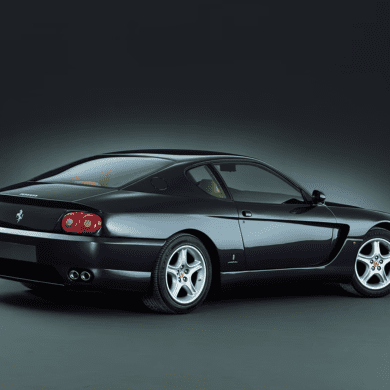
Ferrari 456 GT
Type: Production Car
Years: 1992 - 1997
Production: 1,548 units
Engine: 5.5 L Nat Asp V12
Power: 436 bhp @ 4500 rpm
Torque: 406 lb/ft @ 4250 rpm
0-60 mph: 5.2 seconds
Top Speed: 186 mph
The 456GT has a 5.5-litre front-mounted V12 producing 436bhp, driving the rear wheels through a six-speed manual gearbox and a dog-leg gate (was changed to H pattern in 1995). All of this performance could be managed from a cockpit that provided Connolly leather appointments for four and every other comfort expected of a $245,000 automobile, including a cockpit-adjustable suspension.
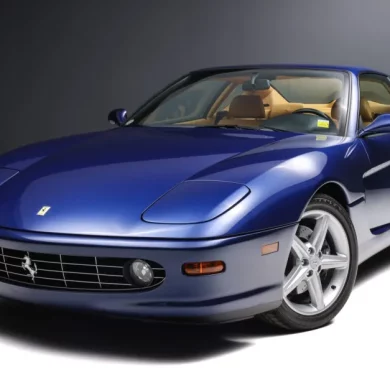
Ferrari 456 GTA
Type: Production Car
Years: 1993 - 1997
Production: 403 units
Engine: 5.5 L Nat Asp V12
Power: 436 bhp @ 4500 rpm
Torque: 406 lb/ft @ 4250 rpm
0-60 mph: 5.2 seconds
Top Speed: 186 mph
This front-engined 2+2 grand tourer had a 436 hp, 5.5-liter V-12 mated to a six-speed gearbox that propelled it from 0-60 in just over 5 seconds on its way to a top speed of 186 mph. Shortly after Ferrari introduced the 456 GT, the 456 GTA became available, the “A” signifying a four-speed automatic gearbox. It was a good option for a GT and sold decently well, but still about a third of the number of the manual.
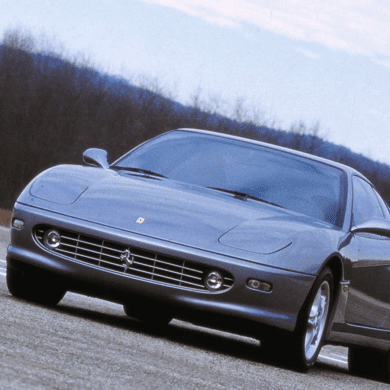
Ferrari 456M GT
Type: Production Car
Years: 1998 - 2003
Production: 688 units
Engine: 5.5 L Nat Asp V12
Power: 442 bhp @ 6250 rpm
Torque: 406 lb/ft @ 4500 rpm
0-60 mph: 5.0 seconds
Top Speed: 186 mph
The 456M (M standing for Modificata) was unveiled in 1998, starting with chassis number 109589. Many changes were made to improve aerodynamics and cooling and the interior was refreshed with new seats and other conveniences (fewer gauges on the dash, and a new Becker stereo fitted in front of the shifter. The 456 had a smaller grille with fog lights outside the grille and other design tweaks.
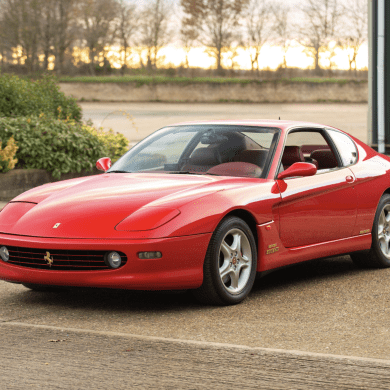
Ferrari 456M GTA
Type: Production Car
Years: 1998 - 2003
Production: 650 units
Engine: 5.5 L Nat Asp V12
Power: 442 bhp @ 6250 rpm
Torque: 406 lb/ft @ 4500 rpm
0-60 mph: 5.0 seconds
Top Speed: 186 mph
The 456M (M standing for Modificata) was unveiled in 1998, starting with chassis number 109589. Many changes were made to improve aerodynamics and cooling and the interior was refreshed with new seats and other conveniences (fewer gauges on the dash, and a new Becker stereo fitted in front of the shifter. The 456 had a smaller grille with fog lights outside the grille and other design tweaks.
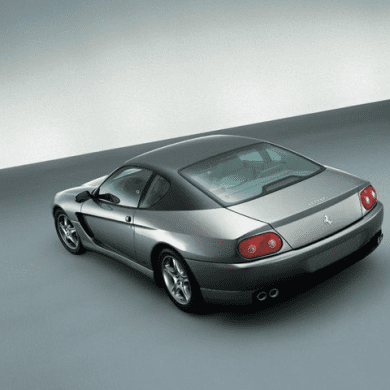
Ferrari 456M GT Scaglietti
Type: Special Edition
Years: 2002 - 2003
Production: 30 units
Engine: 5.5 L Nat Asp V12
Power: 442 bhp @ 6250 rpm
Torque: 406 lb/ft @ 4500 rpm
0-60 mph: 5.0 seconds
Top Speed: 186 mph
In the final year of production, customers could specify their vehicle using the Carrozzeria Scaglietti Program. Ferrari introduced this special two-tone version as a further example of the personalization opportunities offered by the personalization programme, adopted by 90% of Ferrari’s clientele. In the case of the 456M GT displayed on the Ferrari stand, and expressly designed for Michael Schumacher.
Ferrari 456 Buyer's Guide
Buying Tips & Things to Look for When Buying A Used Ferrari 456
The Ferrari 456, produced from 1992 to 2003, is a rare blend of Ferrari’s V12 power with the elegance and comfort of a grand tourer. As one of the brand’s few front-engine, four-seat coupes, it holds a unique appeal. While relatively understated for a Ferrari, it exudes luxury and performance. Here’s what to look for when considering a Ferrari 456, covering critical areas of maintenance, typical issues, and insights into its desirability and future investment potential.
1. Engine and Timing Belt Health
The Ferrari 456 is powered by a 5.5-liter naturally aspirated V12, producing around 436 horsepower. This engine is smooth and powerful but requires careful maintenance to avoid costly repairs.
Timing Belt Service: The 456 uses a timing belt instead of a chain, and it’s crucial to replace it every 3-5 years or 30,000 miles. This is an engine-out service, which can be expensive, so verify that any prospective car has a recent timing belt replacement.
Oil Leaks: Common sources of oil leaks in the 456 include the valve covers and cam seals. Inspect the engine for any signs of leakage, which can lead to bigger issues if not addressed. Documentation of leak repairs is a plus.
Motor Mounts: Worn engine mounts can cause vibrations and misalignment in the drivetrain. Listen for excessive vibration or engine movement, especially during acceleration, as these indicate worn mounts.
2. Transmission and Clutch Condition
The Ferrari 456 was available in both a gated 6-speed manual and a 4-speed automatic (456 GTA), each with specific maintenance requirements.
Manual Transmission: The 6-speed manual is highly desirable among enthusiasts. Test for smooth, precise shifts, especially in second gear, which can wear over time. Any grinding or difficulty in engaging gears can indicate synchro or clutch wear.
Automatic Transmission (456 GTA): The 456 GTA’s 4-speed automatic transmission is generally reliable but expensive to repair if issues arise. Ensure smooth shifting with no hesitation, and confirm that the transmission fluid has been changed regularly.
Clutch Health: Clutch wear is common in both manual and automatic models. A recent clutch replacement is ideal, as replacement can be costly. Be alert to any signs of clutch slipping or difficulty in engaging gears.
3. Suspension and Handling Components
The 456’s suspension setup combines comfort and handling, but age and wear can lead to various issues.
Suspension Bushings: Bushings on the 456 tend to wear over time, especially in higher-mileage cars. Look for clunking sounds or vague handling, which may indicate worn suspension bushings.
Rear Self-Leveling Suspension: The 456 has a unique rear self-leveling suspension system that is costly to repair if it fails. Check for any signs of uneven ride height, sagging, or suspension instability, as these could indicate a problem with the self-leveling shocks.
Shock Absorbers: Inspect for leaking shocks or worn dampers, which can affect ride quality and handling. Replacing shocks on the 456 can be pricey, so check for recent replacements.
4. Braking System
The 456’s braking system is built for high performance, but its components are susceptible to wear over time.
Brake Discs and Pads: Ensure that the brake discs and pads have sufficient life left, as replacing these components can be expensive. Look for any signs of warping, which can cause vibration during braking.
Brake Fluid and Lines: Regular brake fluid changes are essential, as old fluid can compromise braking efficiency and cause damage to the ABS system. Inspect the brake lines for any signs of leakage or aging.
5. Cooling System and Radiators
The Ferrari 456’s cooling system is critical for preventing engine overheating, particularly in warm climates.
Radiator Condition: The radiators are susceptible to damage from road debris and corrosion over time. Inspect for any coolant leaks or buildup of debris around the radiator fins, which can obstruct airflow and impact cooling efficiency.
Water Pump and Thermostat: Check the condition of the water pump and thermostat, as they can wear over time and lead to overheating. Look for documentation showing recent replacement of these components, which is ideal for older models.
Coolant Flushes: Regular coolant flushes are important to maintain system health and prevent corrosion. Confirm that the car’s coolant has been replaced according to Ferrari’s recommended intervals.
6. Electrical System and Interior Components
The Ferrari 456 is known for certain electrical issues, and the interior’s luxury features require careful inspection.
Window Regulators: One of the most common issues in the 456 is malfunctioning window regulators, leading to windows that don’t seal properly, which can result in wind noise and water ingress. Test the windows for smooth operation and proper sealing.
Sticky Interior Plastics: Like many Ferraris of this era, the 456 can develop sticky buttons and interior plastics, a result of heat and wear over time. This issue is mostly cosmetic but can detract from the car’s appearance.
Climate Control System: The 456’s climate control system can be temperamental, so verify that the air conditioning, heating, and blower fan operate smoothly. Any issues here may require a costly fix.
Battery and Electrical Connections: Given that many 456s are driven infrequently, battery drain can be a concern. A trickle charger can help maintain battery health, and it’s wise to check for recent battery replacement and well-maintained electrical connections.
7. Bodywork and Frame Condition
The Ferrari 456 has a combination of aluminum and steel bodywork, making it relatively resistant to rust, but careful inspection is still recommended.
Rust and Corrosion: While generally resistant, the 456 can develop corrosion around the door sills, underbody, and wheel arches. If the car has been exposed to harsh conditions, inspect these areas carefully for any signs of rust or bubbling paint.
Paint Quality and Panel Fitment: Look for consistent paint quality across the body and inspect for signs of repainting, which could indicate prior damage. Panel gaps should be even, and any inconsistencies may require further investigation.
Convertible Top (456 GT Venice): Rare variants like the 456 Venice (custom station wagon and convertible versions) are especially valuable but complex. If considering one of these custom models, ensure that the convertible mechanism is in perfect condition, as repairs can be difficult due to the rarity of parts.
Desirability and Future Investment Potential
The Ferrari 456, especially manual-transmission models, is gaining popularity as collectors and enthusiasts increasingly seek out analog, naturally aspirated Ferraris.
Manual Transmission Desirability: The 6-speed manual transmission is highly sought after, as it provides a more engaging driving experience than the automatic and connects drivers to Ferrari’s legacy of analog, manual V12s. Manual models command a premium in the market and are more likely to appreciate over time.
Growing Collector Interest: The 456 is recognized as one of Ferrari’s last true V12 grand tourers and is increasingly appreciated for its classic design, performance, and usability as a four-seat Ferrari. Enthusiast interest in analog Ferraris is driving up demand, particularly for well-maintained examples with documented service histories.
Rare Variants: The 456’s rarer variants, such as the 456 Venice (produced in extremely limited numbers for the Sultan of Brunei) and the 456 GTA, have added a layer of intrigue to the model’s legacy. While the Venice is not widely available, it has become an interesting part of the 456’s story.
Future Investment Potential: Well-maintained, low-mileage 456s with service records are positioned to appreciate in value as Ferrari continues to move toward turbocharging and hybrid technology. The 456’s analog characteristics, naturally aspirated V12, and understated design make it a solid investment for those seeking a classic Ferrari with long-term potential.
Conclusion
The Ferrari 456 offers an ideal combination of performance, luxury, and practicality, making it a unique grand tourer in Ferrari’s lineup. While maintenance can be expensive, the 456 is a rewarding ownership experience for enthusiasts who appreciate the understated elegance of a classic Ferrari V12. When purchasing, prioritize examples with comprehensive service records, recent timing belt replacements, and well-preserved interiors. With its rising popularity among collectors, the Ferrari 456 represents a unique and potentially valuable addition to any collection, embodying the elegance, power, and tradition of Ferrari’s V12 grand tourers. Whether you’re drawn to its analog driving experience, collectible potential, or just want a Ferrari that balances comfort with performance, the 456 is a timeless choice.
The 456 is a car that flies under the radar. It's not as flashy or extroverted as some Ferraris, but it's a true gem that rewards those who appreciate its understated brilliance.
Motor Trend (at the time of launch)


